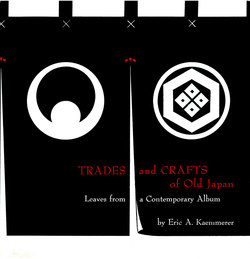Читать книгу Trades and Crafts of Old Japan - Eric A. Kaemmerer - Страница 11
На сайте Литреса книга снята с продажи.
Оглавление3: A Shibori Dyeing Shop
The dyeing process known as shiborizome, which closely resembles the tie-and-dye process of the West, is an old and famous one in Japan. It is used to produce a pattern of white or light-colored areas on a dyed ground and thereby to give a dappled effect and, at the same time, a kind of waffle texture to the cloth. The pattern may be either a small allover one or a large and rather loose one.
In this picture we see several stages of what appears to be the hoshi-shibori process used in earlier times to produce a large loose pattern: the folding of the white cloth before dyeing, the sealing of the drum-shaped containers in which the white areas are protected against penetration by the dye, and the preparations for removal of the dyed cloth from the containers. Unfortunately, we are not shown any finished products in which we can see the pattern produced by the boshi-shibori process. In the mother and child at the center of the picture, we note again the domestic touch which tells us that shop and home are one and the same.
